This article was originally written by Michael Kang, owner of DailyDrivenTJ.com. I take no credit for this article. Just sharing a great how-to article with the TJ community.

When the time came for me to replace the leaky rear main seal on my TJ, I searched online for a decent write up. Some of them were ok, but none of them were good enough to really show the potential DIY to see what is really going down with the repair. Besides many were lacking crucial details, explanations and/or without pictures. I decided to bring something that is more than a write up with 5 pictures. You won't be disappointed with the amount of detail shown in this write up.
Anyhow, chances are, if you own 4.0L I6, you will have a rear main seal leaking on you. As shown in the picture above, the symptom is a engine oil leak between the engine and the transmission. This repair costs anywhere from $300 to $600 depending on where you get the repair done. Surprisingly, all the parts only cost around $50. Not saying it is easy to do, but this repair is not all that hard to do it yourself. With the this guide available in DDTJ, you will know exactly what you are getting yourself into as usual.
Tools and Parts Needed
Here are the pictures of the parts you will need to hunt down.
Anaerobic Gasket Maker (it cures when there is no oxygen.)

Rear Main Seal (2 pieces)
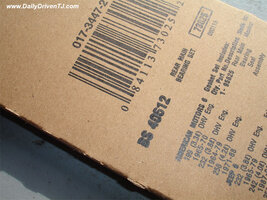
Oil Pan Gasket (Click on the image to see the part number.)
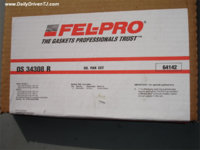
Some instruction that were included in the oil pan seal and the rear main seal.
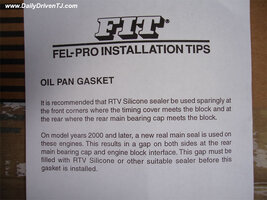
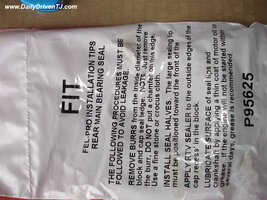
Job Hours
Takes about 2-6 hours.
Procedure
1. Remove the oxygen sensor from the down pipe. Remove the bolts and nuts holding the down pipe to the header. You will have to move the pipe around so that you can lower the oil pan later.
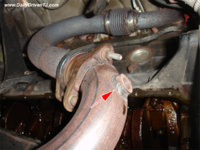
2. Drain the engine oil. I have SureDrain by Fram installed on the oil pan.
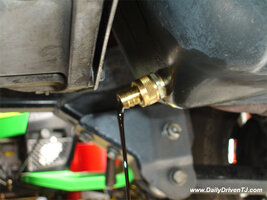
3. Chrysler used different sized bolts to hold the oil pan to the engine block. I think they used 1/2 inch and another size. I took several pictures of the bolts and where they are located so I don't I have to remember them where they go back. Here they are, for your reference. Start removing them and put them in a safe place.
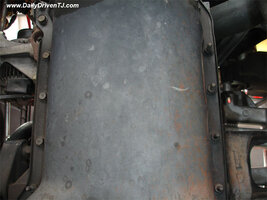
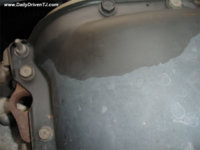
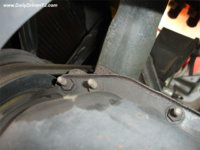
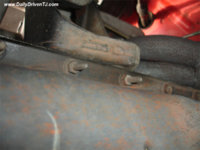
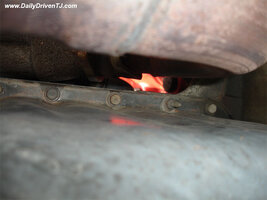
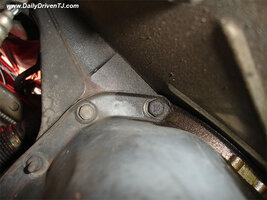
4. Once the oil pan is out of the Jeep, this is what it looks like. Your engine may look different with less brown. My Jeep is 10 years old, JFYI.
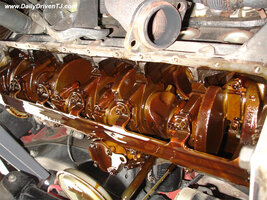
5. Remove the main bearing cap brace by removing 12 bolts. This is the long stick shown in the following picture.
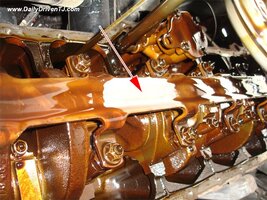
6. With the main bearing cap brace removed, remove the rear main bearing cap.
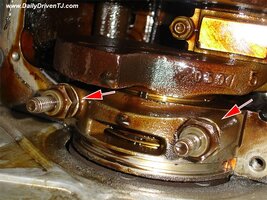
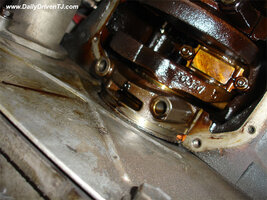
You will have to wiggle the cap loose front to back, not side to side.
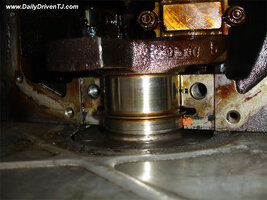
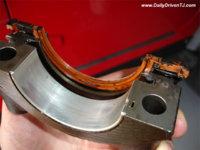
7. Remove the top half of the seal by driving it out of the block. Use extreme caution not to score/dent/scratch anywhere. One small nick or scratch can cause leak and is no longer repairable. As you remove the seal, note the orientation of the seal. The seal is opening towards the front of the vehicle.
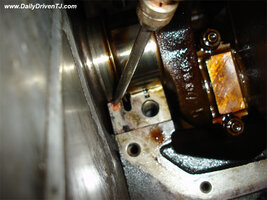
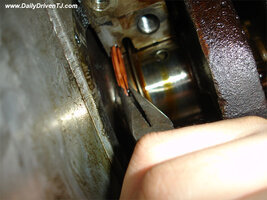
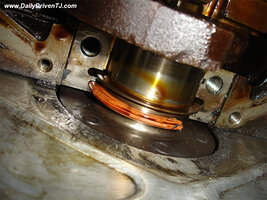
Here is what they look like removed from the engine. The top half and the bottom half is shown here.
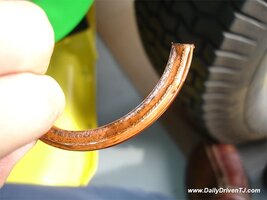
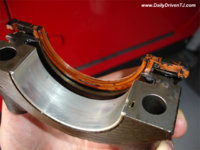
Notice how the old seal has lost its shape. *Blue residue shown on the new seal is wheel bearing grease.
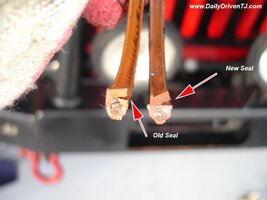
8. Start cleaning the mating surfaces. Make sure things are cleaned down to the metal without removing any metal. I used old tooth brush with a lot of elbow grease. Make sure there is no oily residue left. This is ABSOLUTELY CRUCIAL for the success of this repair. One little residue of old sealant will cause leak. Oiled surface does not allow the adhesive to adhere properly. I used a paint prepping agent to clean the surface. Pay particular attention to the areas indicated by the arrow.
Before
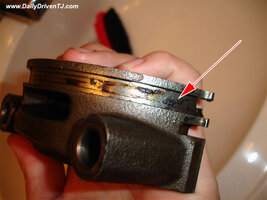
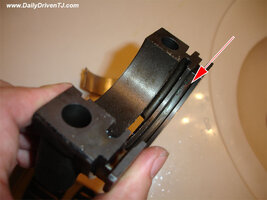
After
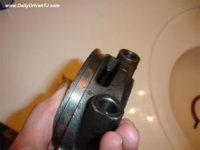
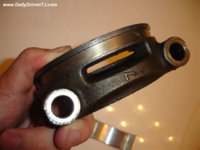
While you are cleaning the bearing cap, if the bearing falls out of the cap, put it back on the cap with a bit of grease to go between the two pieces. It only goes in one direction.
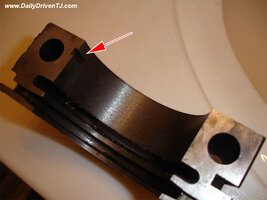
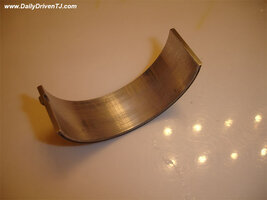
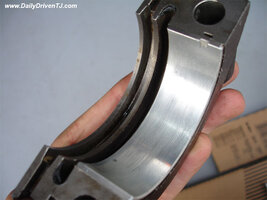
Clean the engine block where the bearing cap mates against free of any residue whatsoever! This cannot be stressed enough! Clean ANY mating surface ABSOLUTELY free of any old sealant and any type of residue!! Remember you have to do this WITHOUT damaging/scoring the metal!
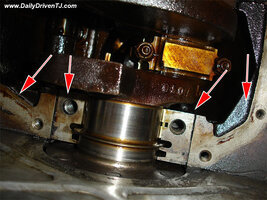
This is a picture of two pieces of paper towels. Left one is used to absorb the oil from the bottom of the oil pan. The one on the right is virgin oil. There was considerable amount of solid stuck on the bottom of the oil pan.
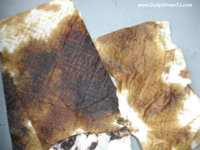
9. Start cleaning the oil pan. Remove the old gasket and clean the mating surface with mild wire wheel. I cleaned the surface with paint prepping agent once again. this gets rid of any oil residues left behind.
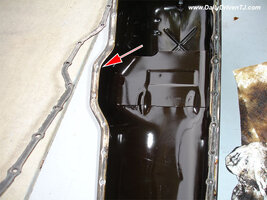
Here is how they should look after you are done cleaning.
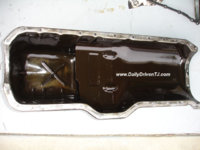
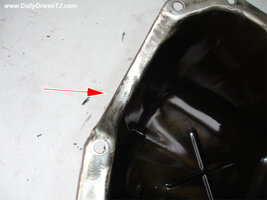
10. Install the upper half of the seal after lubing with some engine oil. DO NOT PUT ANY SEALANT ON THIS SEAL! With the seal's lip opening towards the front of the vehicle.
*Here is one crucial detail that every online write up fails to emphasize. As you push in the upper half of the seal, if you do not follow (as you push the seal) the circle channel carefully, you will cut the seal and this will guarantee the rear main seal to leak again.
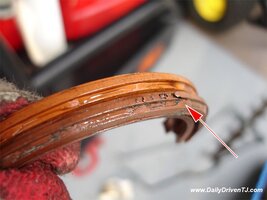
So how do you install the upper seal without cutting it up? Fel-Pro included this nifty thin plastic that you wedge between the channel and the seal to keep it from getting cut. *I saw the same seal kit that included this plastic piece, and some did not. Your mileage may vary.
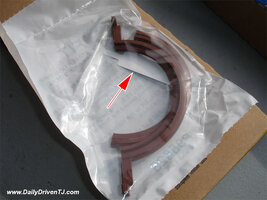
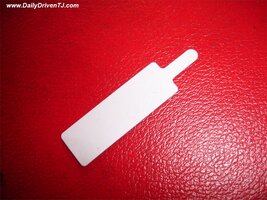
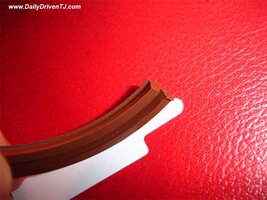
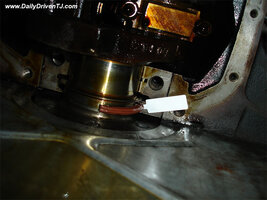
Notice the orientation of the seal where the mouth of the seal opens toward the front of the vehicle. Once seal is in place, simply pull the plastic out.
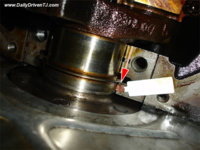
11. Start applying Chrysler Anaerobic Sealant or Loctite 518 on the rear main bearing cap mating surfaces as shown in the following picture. You DO NOT NEED MUCH. It is CRUCIALthat you DO NOT get any of this sealant on the lip of the seal! Make sure you compensate for the spread of the sealant once it is jammed between the surfaces. Put some engine oil on the bearing!!
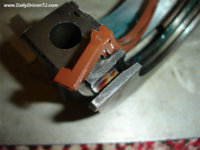
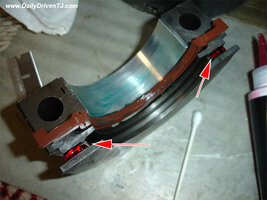
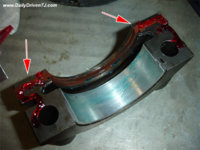
*Anaerobic Sealant starts curing after when it is isolated from the atmosphere unlike most RTVs. Some may say they got away with using RTV. They got away. I am not sure if you will. I also noticed the anaerobic sealer had different viscosity compare to the red RTV that I used on the oil pan gasket. BTW it is the factory service manual that is calling for this Loctite 518 or equivalent. There is no Loctite 518 available in the local part store which is the anaerobic sealant. You will have to get this sealant from the dealer.
12. Install the main bearing cap and torque the bolts to 80ft.lbs.
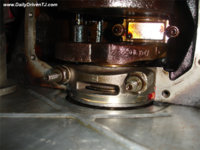
13. Install the bearing brace and torque the bolts to 35ft.lbs.
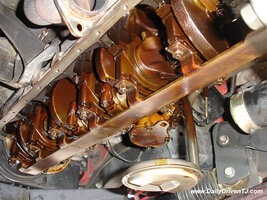
14. Place the oil pan gasket on the pan. I used RTV on the crucial area at the front of the block and where the rear bearing cap. I can use RTV here, because this is to seal something that is not moving against anything. Notice that I used RTV on both the top and the bottom of the oil pan gasket. *MAKE SURE YOU CLEAN THE MATING SURFACE OF THE ENGINE BLOCK FREE OF ANY SEALANT AND OILY RESIDUE! I used paint prepping solvent to clean the surface.
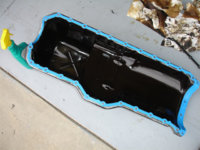
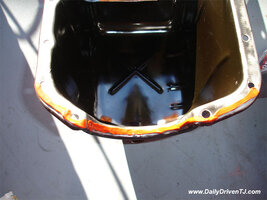
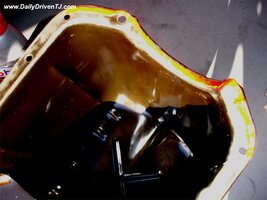
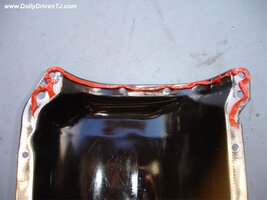
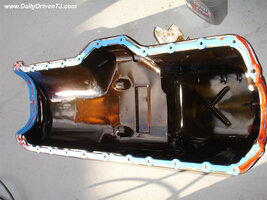
15. Install the oil pan but while doing so make sure the rear main bearing cap's groove lines up with the oil pan gasket. Also pay particular attention to gasket on the front of the engine. It has built in grooves that has to sit just right. Tighten the bolts to 84in/lbs for the 1/4" bolts, and 132in/lbs for the 5/16" bolts.
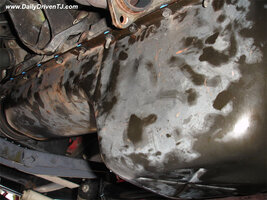
16. Install the down pipe back on the header and install the oxygen sensor back on the down pipe and JUST hand tight it down. It just needs to be on there tight enough so it won't fall back out on its own.
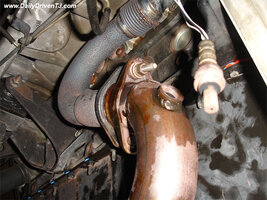
17. Replace the oil filter and put in 5qt of oil and watch the dip stick to top off. *I learned my jeep even tough it was almost bone dry (which I left it to drain for two days while I was working on the rear end.) it did not take the full 6qts. More like 5 and 1/2 qts total to have it read "Full" on the dip stick.
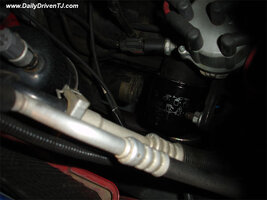
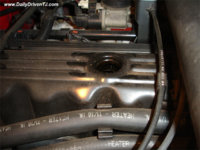
18. Enjoy leak free engine! No more oil spots on the driveway! Pat yourself on the back, you saved a few hundred dollars!
When the time came for me to replace the leaky rear main seal on my TJ, I searched online for a decent write up. Some of them were ok, but none of them were good enough to really show the potential DIY to see what is really going down with the repair. Besides many were lacking crucial details, explanations and/or without pictures. I decided to bring something that is more than a write up with 5 pictures. You won't be disappointed with the amount of detail shown in this write up.
Anyhow, chances are, if you own 4.0L I6, you will have a rear main seal leaking on you. As shown in the picture above, the symptom is a engine oil leak between the engine and the transmission. This repair costs anywhere from $300 to $600 depending on where you get the repair done. Surprisingly, all the parts only cost around $50. Not saying it is easy to do, but this repair is not all that hard to do it yourself. With the this guide available in DDTJ, you will know exactly what you are getting yourself into as usual.
Tools and Parts Needed
- High Temperature RTV
- Oil Pan Gasket
- Rear Main Seal (1997-1999 models)
- Rear Main Seal (2000-2006 models)
- 4318083 (Anaerobic! Not your average RTVs! It is not cheap but required, ~$16 from dealer. No parts stores carry this item.)
- Paint Prepping Solvent
- Sockets and Ratchets with extensions
- Torque Wrench
- 6qts. of Engine Oil
- Oil Filter
Here are the pictures of the parts you will need to hunt down.
Anaerobic Gasket Maker (it cures when there is no oxygen.)

Rear Main Seal (2 pieces)

Oil Pan Gasket (Click on the image to see the part number.)

Some instruction that were included in the oil pan seal and the rear main seal.


Job Hours
Takes about 2-6 hours.
Procedure
1. Remove the oxygen sensor from the down pipe. Remove the bolts and nuts holding the down pipe to the header. You will have to move the pipe around so that you can lower the oil pan later.

2. Drain the engine oil. I have SureDrain by Fram installed on the oil pan.

3. Chrysler used different sized bolts to hold the oil pan to the engine block. I think they used 1/2 inch and another size. I took several pictures of the bolts and where they are located so I don't I have to remember them where they go back. Here they are, for your reference. Start removing them and put them in a safe place.






4. Once the oil pan is out of the Jeep, this is what it looks like. Your engine may look different with less brown. My Jeep is 10 years old, JFYI.

5. Remove the main bearing cap brace by removing 12 bolts. This is the long stick shown in the following picture.

6. With the main bearing cap brace removed, remove the rear main bearing cap.


You will have to wiggle the cap loose front to back, not side to side.


7. Remove the top half of the seal by driving it out of the block. Use extreme caution not to score/dent/scratch anywhere. One small nick or scratch can cause leak and is no longer repairable. As you remove the seal, note the orientation of the seal. The seal is opening towards the front of the vehicle.



Here is what they look like removed from the engine. The top half and the bottom half is shown here.


Notice how the old seal has lost its shape. *Blue residue shown on the new seal is wheel bearing grease.

8. Start cleaning the mating surfaces. Make sure things are cleaned down to the metal without removing any metal. I used old tooth brush with a lot of elbow grease. Make sure there is no oily residue left. This is ABSOLUTELY CRUCIAL for the success of this repair. One little residue of old sealant will cause leak. Oiled surface does not allow the adhesive to adhere properly. I used a paint prepping agent to clean the surface. Pay particular attention to the areas indicated by the arrow.
Before


After


While you are cleaning the bearing cap, if the bearing falls out of the cap, put it back on the cap with a bit of grease to go between the two pieces. It only goes in one direction.



Clean the engine block where the bearing cap mates against free of any residue whatsoever! This cannot be stressed enough! Clean ANY mating surface ABSOLUTELY free of any old sealant and any type of residue!! Remember you have to do this WITHOUT damaging/scoring the metal!

This is a picture of two pieces of paper towels. Left one is used to absorb the oil from the bottom of the oil pan. The one on the right is virgin oil. There was considerable amount of solid stuck on the bottom of the oil pan.

9. Start cleaning the oil pan. Remove the old gasket and clean the mating surface with mild wire wheel. I cleaned the surface with paint prepping agent once again. this gets rid of any oil residues left behind.

Here is how they should look after you are done cleaning.


10. Install the upper half of the seal after lubing with some engine oil. DO NOT PUT ANY SEALANT ON THIS SEAL! With the seal's lip opening towards the front of the vehicle.
*Here is one crucial detail that every online write up fails to emphasize. As you push in the upper half of the seal, if you do not follow (as you push the seal) the circle channel carefully, you will cut the seal and this will guarantee the rear main seal to leak again.

So how do you install the upper seal without cutting it up? Fel-Pro included this nifty thin plastic that you wedge between the channel and the seal to keep it from getting cut. *I saw the same seal kit that included this plastic piece, and some did not. Your mileage may vary.




Notice the orientation of the seal where the mouth of the seal opens toward the front of the vehicle. Once seal is in place, simply pull the plastic out.

11. Start applying Chrysler Anaerobic Sealant or Loctite 518 on the rear main bearing cap mating surfaces as shown in the following picture. You DO NOT NEED MUCH. It is CRUCIALthat you DO NOT get any of this sealant on the lip of the seal! Make sure you compensate for the spread of the sealant once it is jammed between the surfaces. Put some engine oil on the bearing!!



*Anaerobic Sealant starts curing after when it is isolated from the atmosphere unlike most RTVs. Some may say they got away with using RTV. They got away. I am not sure if you will. I also noticed the anaerobic sealer had different viscosity compare to the red RTV that I used on the oil pan gasket. BTW it is the factory service manual that is calling for this Loctite 518 or equivalent. There is no Loctite 518 available in the local part store which is the anaerobic sealant. You will have to get this sealant from the dealer.
12. Install the main bearing cap and torque the bolts to 80ft.lbs.

13. Install the bearing brace and torque the bolts to 35ft.lbs.

14. Place the oil pan gasket on the pan. I used RTV on the crucial area at the front of the block and where the rear bearing cap. I can use RTV here, because this is to seal something that is not moving against anything. Notice that I used RTV on both the top and the bottom of the oil pan gasket. *MAKE SURE YOU CLEAN THE MATING SURFACE OF THE ENGINE BLOCK FREE OF ANY SEALANT AND OILY RESIDUE! I used paint prepping solvent to clean the surface.





15. Install the oil pan but while doing so make sure the rear main bearing cap's groove lines up with the oil pan gasket. Also pay particular attention to gasket on the front of the engine. It has built in grooves that has to sit just right. Tighten the bolts to 84in/lbs for the 1/4" bolts, and 132in/lbs for the 5/16" bolts.

16. Install the down pipe back on the header and install the oxygen sensor back on the down pipe and JUST hand tight it down. It just needs to be on there tight enough so it won't fall back out on its own.

17. Replace the oil filter and put in 5qt of oil and watch the dip stick to top off. *I learned my jeep even tough it was almost bone dry (which I left it to drain for two days while I was working on the rear end.) it did not take the full 6qts. More like 5 and 1/2 qts total to have it read "Full" on the dip stick.


18. Enjoy leak free engine! No more oil spots on the driveway! Pat yourself on the back, you saved a few hundred dollars!

